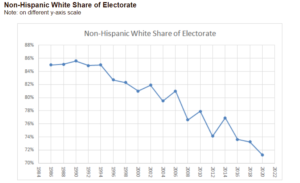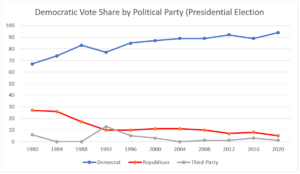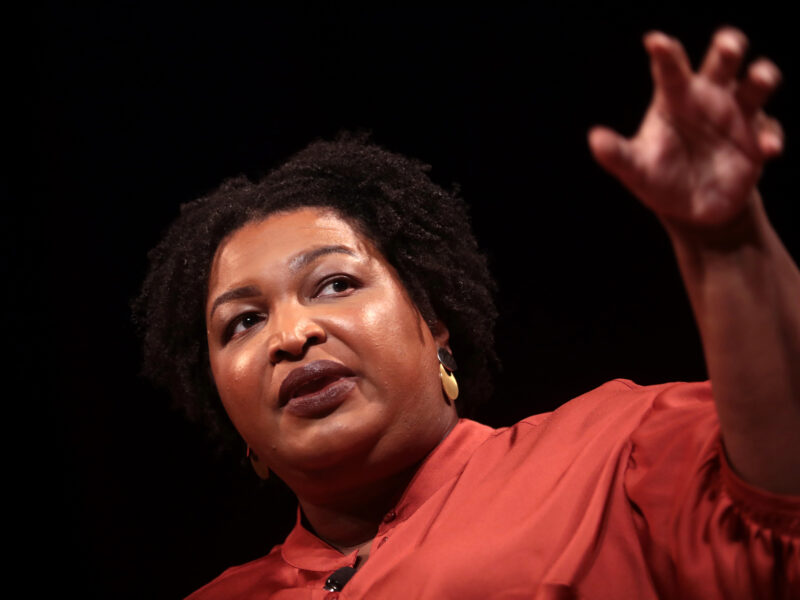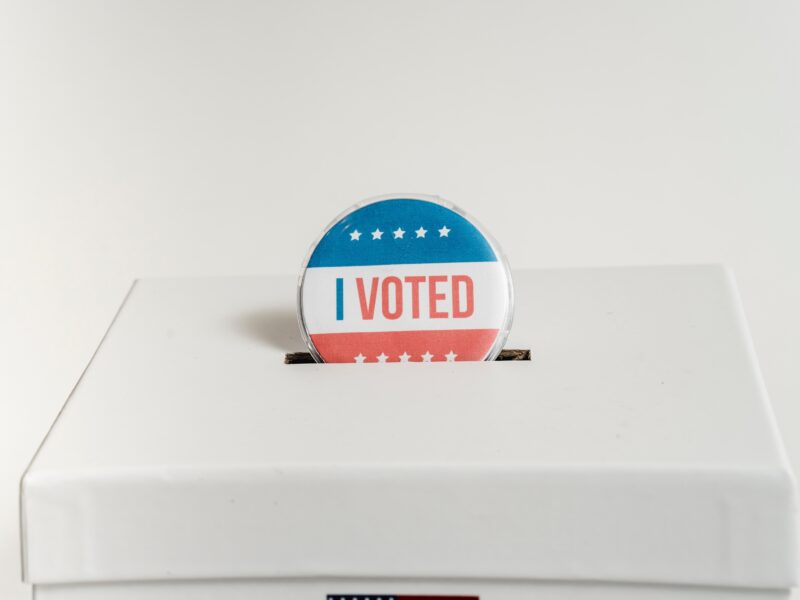This post could literally go anywhere. Despite attempts to focus, it still might go everywhere. This post will address how to win elections (where no great consensus lives), what motivates certain voting groups (where no great consensus lives again), and how that is changing (guess what! . . . where no great consensus lives). To complicate things further, I’ll make broad generalizations about U.S. history, racial and socioeconomic issues, and ongoing U.S. electoral trends. However, I’m pushing forward because what moderate Democrats (“Moderates”) do is still widely important (e.g., how they shut down Sen. Sanders after he won the Nevada Caucuses[1]). With Republicans of all stripes embracing some version of post-1/6 Trumpism, we can’t really wait for history to tell us if Moderates are irrelevant now or not. We must make this assessment right now.
To make this assessment, we’ll look at the current day Moderates’ origin and original purpose, how they took over the party, and what strategy they deployed. From there, we’ll examine whether that original purpose is still relevant and, if not, whether Moderate Democrats’ have adapted well (spoiler alert: I don’t think so.). Then, lastly, we’ll look at what all this means for Moderates going forward.
The Democratic Leadership Council Changes the Modern Party:
While there have been Democrats of all flavors since the 19th century, the current lineage of Moderates can be traced back to The Democratic Leadership Council (“DLC”). By 1985, the Democrats were reeling. The cumulative impact of the Dixiecrats, the Southern Strategy, and the Silent Majority had generated a white and working-class voting group (called the “Reagan Democrats”) that believed the Democratic Party had left them to become the party of women, African-Americans, Latinx, and LGBTQ+ causes. The Reagan Democrats concluded the Democratic Party ignored their economic concerns, pushed unwanted change in their neighborhoods, allowed crime, and exploded the size of government via the deficit and debt in favor of those causes. While Reagan Democrats are specifically Democratic voters that voted for President Reagan, they’re part of a demographic that had been drifting towards Republicans as part of a broader trend in the prior decades. As a result, Presidents Nixon and Reagan won 40+ states in their respective elections winning 49 states at least once. Between 1968 and 1985, Republicans won 4 out of 5 presidential elections (yikes!) and started making gains in Congress and in state and local elections.
In 1980, Rep. Gillis Long (D-LA), the first of many southern Democrats in this story, organized the House Democratic Caucus for Party Effectiveness (“CPE”).[2] Long’s goal was “to bring about party unity, to revive the caucus as an active forum for intraparty debate and policy development, and to use it to reinject House Democrats into more general debate over the identity of the national party.”[3] The CPE held meetings with House Democrats of all kinds and produced policy materials that had minimal impact.[4] The committee encouraged unity by avoiding controversial issues between liberals, in the 80s sense of the word (and more akin to Progressives in current terminology), and Moderates, but lacked capabilities to change the party.[5] The CPE failed to have any policies included in the 1984 Democratic platform.[6]
After Reagan defeated Mondale (this was his 49 states win), which included Republicans maintaining control in the Senate and gaining 14 House seats[7], the Moderates decided to step up their efforts. Needing a vehicle to continue the CPE’s work and raise its media profile, especially after Rep. Long’s death in January 1985, the DLC was founded on February 28th, 1985.[8] CPE’s former Executive Director Al From took the same role in the DLC. Rep. Dick Gephardt (D-MO) served as DLC’s first chairman. Sens. Lawton Chiles (D-FL) and Sam Nunn (D-GA); Govs. Bruce Babbitt (D-AZ) and Chuck Robb (D-VA); and Rep. James R. Jones (D-OK) served as “founding spokesmen.”[9]
Over the next couple of years, the DLC made its arguments via policy forums, public meetings, and media appearances.[10] The 1988 presidential primaries would be the real test of whether this was working.[11] Long story short, the DLC would not pass this test. The DLC had key members either not run (Nunn and Robb), ran on campaign platforms to the DLC’s left (Biden and Gephardt), or use DLC’s rhetoric without its policies (Babbitt).[12] Sen. Al Gore (D-TN) was the only candidate to run as a Moderate.[13] Per Al From, “We were fine until the presidential nominating process got going in earnest, but then that defines the party.”[14] The party would nominate former Massachusetts Gov. Michael Dukakis and proceed to lose 41 states to then-Vice-President George H. W. Bush (for those keeping count that’s 5 out 6 losses and all by losing 40+ states).
This is when the DLC stopped messing around. Between 1989 and 1991, the DLC would build itself into a force within the party. The DLC made many moves to further engrain itself in the Democratic National Committee, boost its membership (most notably to increase membership from state elected officials), and ramp up its fundraising.[15] Surprisingly, the only real opposition to these moves was Rev. Jesse Jackson.[16] Otherwise, the DLC ran pretty much unchecked while its fundraising grew 5x and its membership grew 3.5x.[17] The DLC also focused directly on messaging and agenda setting and moved its policymaking out by creating the Progressive Policy Institute in 1989.[18]
The DLC was making progress, but it knew that the job wouldn’t be done until a DLCer, also known as a “New Democrat”, who fully embraced the messaging, agenda, and policies, won the nomination. In 1990, the DLC made Arkansas Gov. Bill Clinton its chair, and Clinton used the chairmanship to its full potential.[19] Under Clinton, the DLC published its “New Democratic” agenda, which he would later put into the 1992 party platform.[20] In Clinton’s own words, “The change I seek and the change that we all must seek, isn’t liberal or conservative. It’s different and both.” Doubly surprising, Clinton and the New Democrats were still doing this relatively unchecked. New York Governor Mario Cuomo was considered the biggest traditional liberal threat, and he didn’t run.[21] Sen. Tom Harkin (D-IA) was the only traditional liberal left but gained no traction.[22] Sen. Paul Tsongas (D-MA), Clinton’s main competitor, was actually to Clinton’s political right on the economy, the election’s biggest issue.[23] Clinton used the DLC’s network, policies, and message to beat Tsongas and earn the nomination. He would go on to beat President Bush, and the DLC took over the party.
And they’ve seemingly had the party since then. Vice President Al Gore (yep same one from ’88), the party’s 2000 presidential nominee, was a New Democrat. While not officially carrying the DLC’s banner, Sen. John Kerry, the party’s 2004 nominee, was embraced by the New Democrats,[24] and he adopted New Democrat policies for his platform.[25] In 2009, President Obama said plainly, “I am a New Democrat.”[26] In 2016, Secretary Hillary Clinton was the first New Democrat to face a significant challenge from the left (ever?) via Sen. Sanders. And, of course, President Biden had DLC affiliations back in ’88. Even though the DLC closed shop in 2011, its effect is still felt through the Progressive Policy Institute, the New Democrat Network, and the Third Way. Moderates entered the stage in ’92 and haven’t left. We’ll need to analyze the relevance of their original mission to determine whether they should reformulate.
The Moderates Need to Rethink:
We’ve established that Moderates designed their message, policy, and agenda to earn the votes of Reagan Democrats. By way of reminder, Reagan Democrats are white working-class voters that believe the Democratic Party ignored their interests for those of women, African-Americans, Latinx, and LGBTQ+ causes, which ultimately left them with unwanted changes and economic concerns. As summed up by Jon Hale, author of The Making of New Democrats (cited previously in this post):
In attacking liberal fundamentalists, the DLC is signaling to swing voters in the white, middle class that Democrats are not exclusively black, feminist, gay, and liberal. While this message is offensive to the groups mentioned, it holds the potential to wedge the Democrats’ foot in the door of voters who make the difference in presidential elections and many subpresidential elections.
No wonder Jesse Jackson consistently opposed the DLC. Thus, the Moderates formed an electability thesis based on winning over some Reagan Democrats while being, at a minimum, a tolerable Democratic alternative for the other groups. Anyone (i.e., too conservative or progressive) venturing from this thesis would be deemed unelectable and fail to gain the nomination. The key question now is whether this electability thesis is still sound enough to build full political strategies and policy agendas around it.
Shrinking of Support for Moderate’s Electability Thesis:
Changing Demographics:
At the time, this group’s strategic importance was clear. Starting with race, white voters would make up 85% or greater of the electorate in presidential elections from 1980 to 1992.[27] From a working-class perspective, 59% of voters in 1988 earned between $25k-$100k.[28] While income ranges in the data vary from year to year, it is safe to assume that most of the electorate would be working and middle class in any presidential election. However, as time moves on, a different story plays out in terms of race. Per the United States Election Project[29]:

As this chart shows, the white share of the electorate has been declining since before President Clinton’s re-election. Broader population changes have also led some to conclude that the Republican base, where some Reagan Democrats are undoubtedly found nowadays, is shrinking.[30] This has also been timed with an uptick in voter turnout among other racial groups.[31]
Changing Views on Key Issues:
President Reagan was fully assaulting the idea of active government when the Moderates were coming together. In a perfect world, we’d have comparable issue polling data from the 80s. However, it is a fair assumption that single-payer healthcare (Medicare for All), free state and public university tuition, and a wealth tax would have polled poorly or failed to receive serious consideration.
In modern times, these policies remain most prominent with the voting population. Medicare for All is supported by 55% of the people with only 32% opposed, which leaves 13% unsure/no opinion.[32] After more than a decade of debate, the public health insurance option is well supported by the public (68%). Free tuition has 58% support, and the wealth tax has 68%.[33] Even concerns about the federal deficit have waned in the last decade.[34] While restoring trust in government is a long way off, strong majorities believe that the government should play a “major role” on many issues, including health care, infrastructure, and alleviating poverty.[35] By advocating and passing popular policies, people will begin to trust the government again.
Unclear if Reagan Democrats Still Exist and if Moderates Won Them:
Undoubtedly, the legacy of Reagan Democrats still lives on, but we don’t know if they are a true voting segment. In the immediate wake of Hillary’s loss, there was much discussion on the Obama-Trump voters handing Trump his victory, and how Democrats’ needed to win some of them back quickly.[36] Thus, creating an updated version of the Regan Democrats.
Since then, data has emerged challenging this thinking. First, Obama-Trump voters were likely just Republicans that voted for Obama in 2008 and some stuck with him in 2012. “17 percent of Obama voters in 2008 had been for George W. Bush, compared to the 13 percent of Trump voters, the same survey found. These aren’t Obama-Trump voters as much as they were Bush-Obama voters.”[37] A share of Obama-Trump voters simply being Republican also matches the longer-term party switching trend we discussed above. Another study has shown that Obama-Trump voters switched their votes because of racial and immigration issues.[38] Once the 2008 economic concerns fully subsided many Obama-Trump voters reverted to socially conservative positions on race and immigration. Therefore, the Moderate’s electability thesis, and subsequent agenda built on it, is likely either chasing frequent Republican voters or voters that vote conservatively on race and immigration. A tough sell to either group.
In addition to those challenges, I’ll add that it’s not totally clear that the Moderates ever made inroads with the Reagan or Trump Democrats. The Democrats share of the white vote has not improved drastically over the years:

(Data Source: Roper Center for Public Opinion Research)[39]
Despite the Moderate’s hold on the presidential nomination for decades, the blue line has hovered around 40% with white voters, primarily changing for incumbency and elections during tough economic conditions. In 1992, Ross Perot’s third-party bid masked whether Clinton successfully reached the group. But the fact that there wasn’t further competitiveness in this voting block is a high-level indication that the Moderates’ electability thesis and strategy didn’t completely work as planned.
Let’s also not forget that Regan/Trump Democrats were supposed to be Democrats, which means the Moderate’s should be winning more Democrats over time:

(Data Source: Roper Center for Public Opinion Research)
On the surface, this data is more favorable to the Moderates’ electability thesis as the blue line has trended upwards over time. But the Reagan Democrats have been switching parties and more naturally Democratic voting groups have been increasing in share during this time. Both trends would help any type of Democrat capture more Democratic vote share. Additionally, the blue line was already trending upwards before the DLC takeover in 1992. Essentially, the post-party switching world the DLC feared may have become a reality.
Conclusion:
Obviously, there’s a lot of data and debate about how elections are won and the parameters surrounding whether a past election was successful. And getting to the truly definitive conclusions would take a lot of quantitative and qualitative analysis (that people will still debate afterwards).
However, a lot of my work experience is in business strategy. And if I was sitting in the strategy team room, and a teammate tried to convince me to base our whole strategy around a key consumer (read: voter) segment that: a) was created 42 years ago; b) is shrinking in share demographically; c) doesn’t move with changes in consumer (read: voter) preferences; and d) potentially never let us really compete for their purchase (read: vote) anyways. . . I would honestly ask my teammate if they needed a minute to reset and rethink.
And that’s what I ask Moderates and all of the Democrats to do. Let’s be more transparent about past accomplishments and current conditions to create strategies that prioritize the Democratic party’s potential to reach diverse groups with popular policies that will benefit all people (regardless of their specific demographic).
It will take hard work, but let’s do it to protect the republic.
Sources:
[1] Hunnicutt, Trevor and Lewis, Simon. Biden Lands Key Endorsement Three Days before South Carolina Presidential Contest. Reuters. 26 February 2020. https://www.reuters.com/article/us-usa-election/biden-lands-key-endorsement-three-days-before-south-carolina-presidential-contest-idUSKCN20K1I6
[2] Hale, Jon F. “The Making of the New Democrats.” Political Science Quarterly, vol. 110, no. 2, 1995, pp. 210. JSTOR, https://doi.org/10.2307/2152360. Accessed 23 Jun. 2022.
[3] See note 2.
[4] See note 2 at 211.
[5] See note 4.
[6] See note 4.
[7] https://www.spokesman.com/stories/2020/jun/25/control-house-and-senate-1900/
[8] Hale at 215.
[9] See note 8.
[10] See note 8.
[11] Hale at 217
[12] See note 11.
[13] See note 11.
[14] Hale at 218.
[15] Hale at 218-224.
[16] Hale at 221.
[17] Hale at 220-221.
[18] Hale at 220.
[19] Hale at 227.
[20] Hale at 223.
[21] Hale at 225-226.
[22] Hale at 227.
[23] See note 22.
[24] https://www.newstimes.com/news/article/New-Democrats-adopt-Kerry-as-one-of-their-own-62980.php
[25] https://www.washingtonpost.com/archive/opinions/2004/07/29/democrats-shaky-convergence/2acaa37a-0d23-41a5-8357-a6d47354ebbd/
[26] https://www.politico.com/story/2009/03/obama-i-am-a-new-democrat-019862
[27] https://ropercenter.cornell.edu/how_groups_voted Accessed on 25 June 2022. (citing CBS News Exit Polls)
[28] https://ropercenter.cornell.edu/how-groups-voted-1988 (citing CBS News and New York Times Exit Polls)
[29] http://www.electproject.org/home/voter-turnout/demographics
[30] https://www.cnn.com/2021/08/12/opinions/us-census-republican-party-power-gest/index.html
[31] See note 29.
[32] https://morningconsult.com/2021/03/24/medicare-for-all-public-option-polling/
[33] https://projects.fivethirtyeight.com/sanders-poll-quiz/
[34] https://news.gallup.com/poll/147626/federal-budget-deficit.aspx
[35] https://www.pewresearch.org/politics/2020/09/14/americans-views-of-government-low-trust-but-some-positive-performance-ratings/ (There is Gallup data suggesting a preference for reduced government, but the poll focused on government and taxation generally rather than specific issues (https://news.gallup.com/poll/355838/americans-revert-favoring-reduced-government-role.aspx). Given that elections are generally tied to specific issues, I preferred the greater specificity in the Pew Research data. This approach is supported by Gallup data that confirms Pew’s conclusions on healthcare (https://news.gallup.com/poll/4708/healthcare-system.aspx)).
[36] https://www.nytimes.com/2017/03/28/upshot/a-2016-review-turnout-wasnt-the-driver-of-clintons-defeat.html?rref=collection%2Fbyline%2Fnate-cohn&action=click&contentCollection=undefined®ion=stream&module=stream_unit&version=latest&contentPlacement=15&pgtype=collection and https://www.nytimes.com/2017/08/15/upshot/the-obama-trump-voters-are-real-heres-what-they-think.html
[37] https://www.washingtonpost.com/opinions/theres-no-such-thing-as-a-trump-democrat/2017/08/04/0d5d06bc-7920-11e7-8f39-eeb7d3a2d304_story.html
[38] https://news.ucr.edu/articles/2019/07/23/what-was-behind-vote-switching-2016-election and See note 36.
[39] See note 27.



